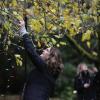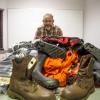April 28, 1998 - 5:00pm
The tension in the multi-media lab is noticeable as you stick your head in the door. The eyes of the three people in the room are glued to the computer screen as Liz Hammond-Kaarremaa, manager of educational technology at Malaspina University-College, calls up scores of images of wild animals onto the screen.
As the images appear, Dr. Chuck Chestnut, instructor in Malaspina's resource management officer technology program, and student, Darren Salisbury add information to each page of the CD-Rom they are producing.
The threesome are in the final stage of producing a CD titled BC Wildlife: Selected BC Mammals, one of a growing handful of multi-media projects that have been produced at Malaspina University-College, recently.
In another office, biology instructor Dr. Tim Goater is working with, multi-media designer Mary O'Neil to put the final touches on a CD called Interactive Exploration of Marine Parasitic Crustacea. Here, the mood is also tense.
Both teams are working on a deadline for a presentation for faculty on Educational Technology, to be held next week as a trial run for a much larger province-wide conference, Connections 98, to be held in Vancouver on May 10.
The first Connections conference was held in 1996 with a strong representation by Malaspina instructors who presented some early multi-media projects to an elite group of educational technology pioneers from B.C.'s post-secondary system. The 1998 conference promises to be a much larger gathering with many more presenters than two years ago.
"Multi-media has become a buzzword of the '90's," said Hammond-Kaarremaa. "Rightfully so. The ability of the CD-Rom, for example, to present information in an interactive format using sound, video clips, photos, and text together, is an incredibly powerful teaching tool. Students can use CDs for research and learning at their own speed. It gives teachers another tool to convey information in a format that captures the imagination of today's computer literate and visually aware students. However, as in any medium, its usefulness as a teaching tool is totally dependent on the quality of its content."
The content of Malaspina's two latest CD-Rom projects are specific to B.C. and deal with two divergent fields of natural science: that of mammals and marine parasites. Both projects are unique to B.C. and highly complex and specialized studies.
According to Chestnut The BC Wildlife CD is the first phase of a project that will eventually include all the mammals of B.C.
"In this version, users will find information on the taxonomy, identification, habitat, behaviour, reproduction, food and feeding of 30 mammals," said Chestnut. "Maps show the distribution of each species or subspecies plus a glossary of terms, useful websites and other information sources. There's a tremendous amount of information and details to be organized into multi-level search paths, he said."
Goater's CD project is the continuation of an earlier project called the Interactive Parasites that combined text with photography, sounds, and a new medium adopted by Goater and Hammond-Kaarremaa called videomicroscopy.
The two were on a field trip to Bamfield with a group of students from a parasitology course, when they learned what a world of discovery opens up when you put a high-powered microscope, a video camera, a VCR and a TV together to investigate new parasites in the field.
"The excitement in the students' voices as they used this new tool showed us that this is educational technology at its best," said Hammond-Kaarremaa. "The technology allows you to magnify live marine parasites on a TV screen many thousands of times larger than the actual creature under the microscope."
According to Goater, students can now observe and record live microscopic parasites in their host habitat--be it the gills or heart of a fish, or photographs of barnacles taken from the back of a whale.
"In addition, the technology allows students to 'freeze frame' the critter with the VCR for in-depth study and then record a single frame or a video sequence onto a CD-Rom. The CD-Rom combines the excitement of the original discovery with much more in-depth information, an index and glossary plus a list of live on-line World Wide Web/Internet resources," said Goater.
"This is a powerful teaching aid that takes learning a long way past textbook learning. This is the topic for our presentation, next week, in which we'll discuss the value of digital technologies as a teaching aid," said Goater. "We're convinced of the value. Now it's a challenge to convince our Ministry and curriculum developers that CD-Rom projects like this are worthy of support."
What is the future of multi-media projects like these at Malaspina? Will we see more of them?
"So far Malaspina instructors have undertaken these projects because they personally believed in them and were willing to put in the time and the energy," said Hammond-Kaarremaa. "Unfortunately, at the moment, funding for leading-edge technology like this is limited."
Malaspina University-College established a reputation for developing innovative multi-media projects on a shoestring-budget in the early stages of the new technology. Forestry instructor Doug Corrin's CD-Rom The Tree Doctor is a success with the Forest Ministry who use it as a reference for diagnosing diseased and blighted trees in B.C. Automotive instructors Gary Doolin and Dan Lines developed a CD-Rom called Battery Testing that is used to teach how to diagnose problems and maintain car batteries. History instructor Patrick Dunae produced Maps, Manuscripts & Multimedia, a CD tracing The City of Nanaimo's origins in the 1800's, while recreation and tourism instructor Sharon Kelly developed a CD called Recreation Program Planning.
"These multi-media projects take an incredible amount of time and effort to produce," said Chestnut. "For example, it took us 300 hours to scan, digitize and add information to the map section of the B.C. Wildlife CD alone. The project has taken two years to complete, but it has been worth it."
"We feel that once the Ministry of Advanced Education, Training and Technology and the Ministry of Environment, Lands and Parks see it, they will want to fund it to make it marketable to all sorts of agencies and groups for teaching and research purposes," said Chestnut.
Hammond-Kaarremaa agrees with him. "I'd like to develop a partnership with public and/or private corporations that would enable us to take these projects to the next level, that of being able market them. For that they need some professional polish. Once that happens, I believe we can find opportunities for our faculty to develop multi-media curriculum materials that lead the world."
Tags: In the Community






